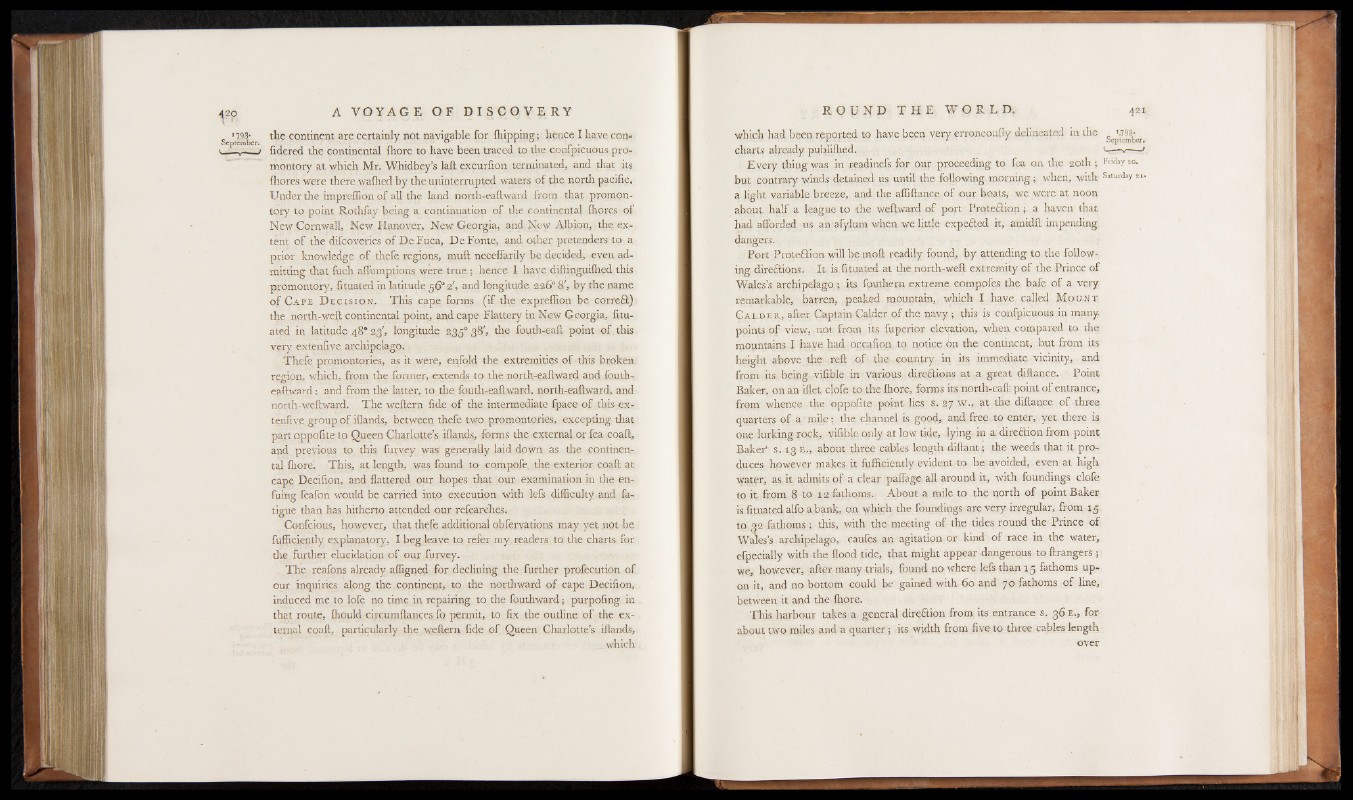
4 ?p A V O Y A G E O F D I S C O V E R Y
the continent are certainly not navigable for (hipping; hence I have con-
lidered the continental fhore to have been traced to the confpicuous promontory
at which Mr. Whidbey’s laft excurfton terminated, and that its
fliores were there wafhed by the uninterrupted waters of the north pacific.
Under the impreffion of all the land north-eaftward from that promontory
to point Rothfay being a continuation of tire continental fhores of
New Cornwall, New Hanover, New Georgia, and New Albion, the extent
of the difcoveries of DeFuca, De Fonte, and other pretenders to a
prior knowledge of thefe regions, muff neceffarily be decided, even admitting
that fuch alfumptions were true ; hence I have diftinguifhed this
promontory, fituated in latitude 56° 2', and longitude 226° 8', by the name
o f C a p e D e c i s i o n . This cape forms (if the expreffion be correCi)
the north-weft continental point, and cape Flattery in New Georgia, fituated
in latitude 48’ 23', longitude 2350 38', the fouth-eaft point of. this
very extenfive archipelago.
Thefe promontories, as it were, enfold the extremities of this broken
region, which, from the former, extends to the north-eaftward and fouth-
eaftward; and from the latter, to the foutli-eallward, north-eaftward, and
north-weftward. The weftern fide o f the intermediate fpace of this extenfive
group of iflands, between thefe two promontories, excepting that
part oppofite to Queen Charlotte’s iflands, forms the external or fea coaft,
and previous to this furvey was generally laid down as the continental
fhore. This, at length, was found to compofe the exterior coaft at
cape Decifion, and flattered our hopes that our' examination in die en-
fuing feafon would be carried into execution with 4efs difficulty and fatigue
than has hitherto attended our refearches.
Confcious, however, that thefe additional obfervations may yet not be
fufficiently explanatory, I beg leave to refer my readers to the charts for
die further elucidation of our furvey.
The reafons already affigned for declining the further profecution of
our inquiries along the continent, to the northward o f cape Decifion,
induced me to lofe no time in repairing to the fouthward; purpofing in
that route, fhould circumftances fo permit, to fix the outline o f the external
coaft, particularly the weftern fide of Queen Charlotte’s iflands,
which
R O U N D T H E W O R L D . 421
which had been reported to have been very erroneoufly delineated in the
charts already publiffied.
Every thing was in readinefs for our proceeding to fea on the 20th ;
but contrary winds detained us until the following morning; when, with
a light variable breeze, and the affiftance of our boats, we were at noon
about half a league to -the weftward of port Protection; a haven that
had afforded us an afylum when we little expeCted it, amidft impending
dangers.
Port Protection will be moft readily found, by attending to the following
directions. It is fituated at the north-weft extremity of the Prince of
Wales’s archipelago ; its fouthern extreme compofes the bafe of a very
remarkable, barren, peaked mountain, which I have, called M o u n t
C a lde r , after Captain Calder of the navy ; this is confpicuous in many,
points of view, not from its fuperior elevation, when compared to the
mountains I have had occafion to notice 6n the continent, but from its
height above the .reft of the country in its immediate vicinity, and
from its being .vifible in various directions at a great diftance. Point
Baker, on an iflet clofe to the fhore, forms its north-eaft point o f entrance,
from whence, the oppofite point lies s. 27 w., at the diftance o f three
quarters of a mile ; the channel is good, and free to enter, yet there is
one lurking rock, vifible only at low tide, lying, in a direction from point
Baker1 s. 13 e,., .about three cables length diftant; the weeds that it produces
however makes it fufficiently evident to be avoided, even at high
water, as it admits o f a clear paffage all around it, with foundings clofe
to it from 8 to 12 fathoms. About a mile to the north of point Baker
is fituated alfo abank, on which the foundings are very irregular, from 15
to 32 fathoms; this, with the meeting of the tides round the Prince of
Wales’s archipelago, caufes an agitation or kind of race in the water,
efpeeially with the flood tide, that might appear dangerous to ftrangers;
we, however, after many trials, found no where lefs than 15 fathoms upon
it, and no bottom could be gained with 60 and 70 fathoms of line,
between it and the fhore.
This harbour takes a general direction from its entrance s. 36 e ., for
about two miles and a quarter; its width from five to three cables length
over